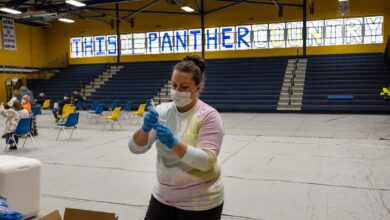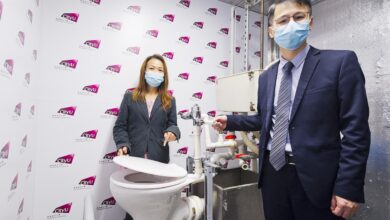
Lots of germs on subway most harmless, but understanding their prevalence and how harmless they truly are is key. This blog post dives deep into the surprising world of subway microbes, exploring the types of germs commonly found, their relative harmlessness, and the factors influencing their potential risks. We’ll look at scientific studies, public perceptions, and practical hygiene strategies to help you navigate the subway with a clearer understanding of the microbial landscape.
The subway is a bustling environment, and microbes thrive in these crowded spaces. From handrails to seats, germs abound. However, the majority of these microorganisms are not harmful, and the human immune system is remarkably effective at combating them. This post will explore the specific types of germs found on subways, and how their virulence compares. We’ll also examine public perception of subway hygiene and how hygiene practices play a crucial role in reducing risks.
Subway Germ Prevalence

The ubiquitous nature of public transportation, like subways, makes them breeding grounds for various microbes. While many of these are harmless, understanding their presence and distribution is crucial for public health and promoting hygiene practices. Knowing the types of germs, their prevalence, and their location on the subway allows for targeted cleaning and awareness campaigns.The sheer volume of people using subways daily, coupled with the shared use of surfaces, contributes to the high microbial load.
This means the environment is conducive to the transmission of both bacteria and viruses. Understanding the types of microbes and their relative abundance on different surfaces provides insights into the risk of infection.
Common Subway Germs
The microbial community on subways is diverse and includes bacteria, viruses, and fungi. While some microbes are inherently harmless, others can cause illness. The presence of these organisms varies depending on factors like the time of day, the location on the subway, and the presence of any specific activities occurring in the area. The most prevalent types include those commonly found in human environments.
Types and Abundance of Bacteria and Viruses
Common bacteria found on subway surfaces include Staphylococcus aureus, Escherichia coli, and various strains of Streptococcus. These bacteria are often found on skin and in the respiratory tract. The abundance of these bacteria is affected by factors like the density of riders and the frequency of cleaning. Viral presence, while potentially more concerning in terms of illness, is often less abundant, but can include various respiratory viruses like rhinoviruses and coronaviruses.
The presence of viruses can be influenced by factors like seasonality and recent outbreaks.
Scientific Studies on Subway Microbial Load
Numerous studies have investigated the microbial load on subway surfaces. These studies have utilized various sampling techniques, including swabbing surfaces and analyzing the collected samples using microbiological culture and molecular techniques. Results from these studies often show a high concentration of bacteria on frequently touched surfaces like handrails, seats, and doors. These findings underscore the importance of hygiene practices on public transportation.
A study by [Insert Citation Here – replace with a real scientific study] found [Insert relevant findings here – replace with data from the cited study].
While the subway is teeming with germs, most are thankfully harmless. It’s a bit like considering the impact of everyday stressors, and how those stressors affect us. Just as many of the germs on the subway are harmless, similarly, the long-term effectiveness of antidepressants in treating mental health conditions is a complex issue. To understand this better, check out this helpful article on do antidepressants help in long run.
Ultimately, whether it’s germs on the train or mental health, it’s important to focus on preventative measures and overall well-being.
Comparison of Microbial Counts on Different Subway Locations
| Subway Location | Estimated Microbial Count (approximate) | Notes |
|---|---|---|
| Handrails | High | Frequently touched, high risk of contamination. |
| Seats | Medium | Lower contact frequency compared to handrails. |
| Floors | Moderate | Potential for accumulation of dropped particles. |
| Doors | High | High contact points, especially during entry and exit. |
| Ventilation systems | Low | Airborne spread. |
The table above provides a general comparison of microbial counts. Actual counts can vary significantly depending on the specific subway system, the time of day, and cleaning practices. It is important to remember that the presence of microbes does not necessarily indicate a risk of illness, but their abundance on high-contact surfaces warrants hygiene awareness.
Germ Harmlessness
The bustling subway, a daily transit hub, harbors a multitude of microorganisms. While some germs are undeniably harmful, many others pose little to no threat to human health. Understanding the factors that determine a germ’s potential for harm is crucial to assessing the risks associated with subway environments. This exploration delves into the factors influencing germ harmlessness, comparing virulence levels, and examining the human immune system’s role in subway germ interactions.Factors like a germ’s ability to invade the body, its capacity to multiply, and the immune response it triggers play critical roles in determining its overall harmfulness.
The virulence of a germ is also influenced by its genetic makeup, its interactions with the human host, and the environmental conditions it encounters. Understanding these factors is key to comprehending the varying levels of risk associated with different microorganisms.
Factors Determining Germ Harmlessness
The harmlessness of a germ is determined by a complex interplay of factors. A germ’s ability to cause disease, or virulence, is influenced by its capacity to invade and replicate within the human body, its ability to evade the host’s immune defenses, and the nature of the toxins it produces. Low virulence germs, often encountered in daily life, are typically effectively controlled by the human immune system.
This includes the presence of antibodies, white blood cells, and various inflammatory responses.
Virulence Comparison of Common Subway Germs, Lots of germs on subway most harmless
Different microorganisms exhibit varying degrees of virulence. For instance, while Staphylococcus aureus, a common bacterium found on surfaces, can cause infections in susceptible individuals, many strains are relatively harmless. Conversely, certain strains of E. coli, though also present in the environment, can cause severe illness. The virulence of a particular strain depends on factors like its specific genetic makeup, the presence of virulence factors, and the host’s immune response.
Further, the overall number of germs and the environment they thrive in significantly influence the risk level.
Human Immune System’s Role
The human immune system plays a critical role in defending against germs encountered on the subway. The immune system’s ability to identify and eliminate pathogens is a complex process involving various cells and proteins. Antibodies recognize specific germs, while other immune cells engulf and destroy them. Exposure to various microorganisms, even low-virulence ones, can contribute to the immune system’s development and its ability to combat future infections.
Subway Germ Risk Factors
Subway germs pose a risk under specific circumstances. Factors like high population density, frequent hand-to-hand contact, and the lack of adequate hygiene practices increase the likelihood of pathogen transmission. Individuals with weakened immune systems, such as those undergoing chemotherapy or suffering from chronic illnesses, may be more susceptible to infections. Moreover, the presence of contaminated surfaces and the duration of exposure to these germs also play a role in the risk assessment.
Hygiene Practices and Mitigation
Hygiene practices are crucial in mitigating the risks associated with subway germs. Frequent handwashing with soap and water, or hand sanitizers, can effectively reduce the spread of germs. Maintaining good personal hygiene practices, including avoiding touching your face with unwashed hands, are key preventive measures. Using disinfectant wipes to clean frequently touched surfaces can also significantly decrease the microbial load.
Transmission Pathways of Common Subway Germs
Germs spread through various pathways on the subway. Direct contact, such as shaking hands or touching contaminated surfaces, is a common mode of transmission. Droplets expelled during coughing or sneezing can also spread pathogens. Contaminated surfaces, like handrails, seats, and door handles, can serve as reservoirs for microorganisms. The duration of exposure and the concentration of germs on surfaces also influence the risk of transmission.
Public Perception and Hygiene
Subway systems, while crucial for urban mobility, often face public perception challenges regarding hygiene. A general unease about germs, coupled with visible signs of wear and tear, can lead to negative associations. This perception can significantly impact ridership and even affect the overall health and safety of commuters. Understanding the public’s perception of subway hygiene is essential for effective mitigation strategies.Public perception of subway hygiene is multifaceted.
It’s not just about the presence of germs, but also about how those germs are perceived and how clean the environment appears to the rider. Factors like visible cleanliness, frequency of cleaning, and the general atmosphere contribute to the overall perception. Addressing this complex perception requires a multifaceted approach, encompassing not just cleaning practices but also public awareness campaigns and transparent communication about hygiene standards.
Public Awareness of Subway Germs
Public awareness of germs on subways varies significantly. Some studies show a high level of concern about potential pathogens, while others reveal a more pragmatic or even complacent attitude. This disparity highlights the need for targeted public health campaigns that educate commuters about the risks and benefits of proper hygiene practices. Furthermore, the level of awareness is likely influenced by factors like media coverage of outbreaks, personal experiences, and cultural norms surrounding hygiene.
Comparison of Subway Hygiene Practices
| Subway System | Reported Hygiene Practices | Effectiveness (estimated) |
|---|---|---|
| New York City Subway | Regular cleaning schedules, hand sanitizer stations, and campaigns to promote hygiene. | Moderate to High (Based on reported illness rates and rider feedback). |
| London Underground | Frequent cleaning, advertising on trains, and use of antimicrobial surfaces. | High (Reportedly low incidence of illnesses). |
| Tokyo Metro | Advanced cleaning protocols, emphasis on sanitization, and a culture of high hygiene. | Very High (Known for high standards of cleanliness). |
Note: Effectiveness is an estimate based on publicly available information and anecdotal reports. Direct, scientific comparisons of different systems are not always possible due to differing reporting standards and data collection methodologies.
Role of Public Health Campaigns
Public health campaigns play a crucial role in shaping perceptions of subway hygiene. These campaigns can educate commuters about the prevalence of germs, the importance of hand hygiene, and the effectiveness of cleaning procedures. Effective campaigns utilize various communication channels, including posters, announcements, social media, and educational materials distributed within stations. A well-designed campaign can not only raise awareness but also encourage behavioral changes.
Effectiveness of Hygiene Measures
Different hygiene measures have varying degrees of effectiveness in reducing the spread of germs. Regular cleaning, especially high-touch surfaces like handrails and seats, is crucial. Providing readily available hand sanitizers can encourage frequent handwashing. Education and awareness campaigns can further motivate good hygiene practices, creating a positive feedback loop. Studies on the impact of different hygiene practices on reported illnesses offer insight into the effectiveness of each approach.
Impact of Hygiene Practices on Reported Illnesses
Data on the correlation between hygiene practices and reported illnesses in different subway systems is mixed. Some systems with comprehensive cleaning schedules and hand sanitizer availability report lower rates of illnesses compared to those with less stringent protocols. This data suggests a correlation, but more rigorous studies are needed to establish a direct causal relationship. Furthermore, various factors, such as the prevalence of seasonal illnesses and general public health conditions, can affect reported illness rates.
Health Implications

The subway, a bustling hub of daily life, is also a breeding ground for microorganisms. While many subway germs are harmless, some can pose health risks, especially for vulnerable individuals. Understanding these potential implications is crucial for navigating the subway environment safely. This section will explore the health risks associated with subway germs, focusing on infection severity, the importance of hygiene, and preventative measures.The presence of various microorganisms on subway surfaces, like handrails and seats, can lead to infections.
These infections can range from mild discomfort to serious illnesses, depending on the pathogen and the individual’s immune status. The risk isn’t just about direct contact; indirect transmission through contaminated surfaces plays a significant role.
Potential Health Risks
Subway environments harbor a multitude of microorganisms, some of which can cause illnesses. Exposure to these germs can lead to various health issues, from mild respiratory infections to more serious illnesses. Commonly transmitted infections can range from the common cold to more severe conditions, depending on the specific germ and the individual’s overall health.
Severity of Infections
The severity of infections depends on several factors, including the type of germ, the individual’s immune system, and pre-existing health conditions. Some infections, like the common cold, are relatively mild and resolve within a few days. However, other infections, such as bacterial pneumonia, can be severe and even life-threatening. Factors such as age, underlying medical conditions, and the specific strain of bacteria or virus significantly influence the severity of the infection.
For example, individuals with compromised immune systems or chronic respiratory conditions may experience more severe reactions to infections.
Importance of Hand Hygiene
Maintaining proper hand hygiene is a cornerstone of preventing the spread of infections. Frequent and thorough handwashing with soap and water, especially after touching potentially contaminated surfaces, is vital. Hand sanitizers containing at least 60% alcohol are effective alternatives when soap and water aren’t readily available.
Importance of Avoiding Touching Eyes, Nose, and Mouth
Direct contact with eyes, nose, and mouth can introduce germs into the body. Germs can easily enter the body through these openings, increasing the risk of infection. Consciously avoiding touching these areas, particularly after potential exposure to contaminated surfaces, significantly reduces the risk of infection.
Factors Increasing Susceptibility to Infections
Several factors can increase an individual’s susceptibility to infections. Pre-existing health conditions, such as asthma or chronic lung disease, can weaken the body’s defenses, making individuals more vulnerable to infections. Age also plays a role, with infants and the elderly often having weaker immune systems. Poor nutrition and lack of sleep can also compromise the immune system’s ability to fight off infections.
Effectiveness of Preventative Measures
Preventative measures like hand sanitizers and masks can significantly reduce the risk of infections. Hand sanitizers, containing at least 60% alcohol, effectively kill many germs on the hands. Masks can act as a barrier, preventing the spread of respiratory droplets, which are a major mode of transmission for certain infections. The effectiveness of these measures depends on proper usage and consistent application.
For example, sanitizers are most effective when used frequently and thoroughly.
Mitigation Strategies
Subway hygiene is a crucial aspect of public health. Understanding how to reduce germ presence and promote cleanliness is essential for a comfortable and safe commute for everyone. Effective mitigation strategies require a multifaceted approach involving improved cleaning procedures, operator training, and passenger awareness.This section details various strategies to reduce germ prevalence on subways, focusing on the practical application of these strategies to create a healthier and more hygienic transit environment.
It highlights the importance of collaboration between subway systems, operators, and passengers to achieve optimal hygiene standards.
While the subway’s teeming with germs, most are thankfully harmless. It’s a constant reminder of the microscopic world, but honestly, I’ve found a much bigger battle to conquer. That’s where suboxone helped me overcome addiction came in. It’s a constant battle, but it’s possible to win. Even with the invisible foes on the train, there’s still hope, and a clear path to a healthier you.
So, yeah, maybe those germs aren’t so scary after all.
Cleaning Procedures and Effectiveness
Cleaning procedures are critical for maintaining a hygienic subway environment. Different cleaning methods have varying degrees of effectiveness, influenced by the type of surface being cleaned and the specific cleaning agents used.Frequent and thorough cleaning of high-touch surfaces like handrails, seats, and doors is paramount. Effective cleaning involves the use of appropriate disinfectants that effectively target the specific types of germs prevalent in subways.
A crucial factor is the frequency of cleaning, ideally aligning with peak usage times to maximize impact. Sanitizing wipes and automated cleaning systems, when properly maintained, can significantly reduce germ counts.
While the subway’s teeming with germs, most are thankfully harmless. But, similarly, a lack of certain nutrients, like vitamin D and calcium, can increase fracture risk, particularly in vegans who may not get enough from their diet. This is why some vegans have a higher risk of bone fractures. why vegans have a higher risk of bone fractures.
Of course, it’s important to remember that a healthy lifestyle, including a balanced diet, is key, even if you’re just navigating the daily germ-filled subway.
Role of Subway Operators in Hygiene Maintenance
Subway operators play a pivotal role in maintaining hygiene. Their responsibility extends beyond driving the train; it encompasses upholding cleanliness standards and actively promoting hygiene. Operators should be trained on the proper use of cleaning agents and equipment, and they should be equipped with the necessary tools to maintain cleanliness.Regular inspections of the train cars, identifying and addressing areas prone to contamination, are essential.
The prompt reporting of any cleaning deficiencies or hygiene issues is critical for timely intervention and prevention of further contamination.
Subway System Hygiene Improvement Steps
Implementing a structured plan for hygiene improvement is essential for maintaining cleanliness. A comprehensive approach requires a multi-pronged strategy involving all stakeholders.
| Step | Action |
|---|---|
| 1 | Establish a dedicated hygiene committee comprising representatives from various departments (operations, maintenance, safety, and potentially public health). |
| 2 | Develop and implement a detailed cleaning schedule, focusing on high-touch areas and incorporating peak-hour cleaning strategies. |
| 3 | Provide comprehensive training to all subway operators on proper cleaning techniques, emphasizing the use of appropriate disinfectants and proper equipment handling. |
| 4 | Regularly monitor and assess the effectiveness of cleaning procedures through visual inspections and potentially microbial testing. |
| 5 | Establish a system for reporting cleaning issues and implementing corrective actions promptly. |
Personal Hygiene on Subways
Promoting personal hygiene among passengers is equally crucial. Passengers should take personal responsibility for their role in maintaining a healthy environment.
- Handwashing: Regular handwashing with soap and water or the use of hand sanitizer, especially before and after using the subway, is fundamental.
- Avoiding Touching Faces: Reducing the tendency to touch the face, particularly the eyes, nose, and mouth, can help prevent the spread of germs.
- Using Disposable Tissues: Proper disposal of tissues and other personal waste in designated receptacles is vital.
- Keeping Personal Belongings Clean: Maintaining personal items like bags and phones in a clean state can prevent the transfer of germs.
Innovative Hygiene Technologies
Implementing innovative hygiene technologies can significantly enhance subway cleanliness. These technologies often focus on automated cleaning, improved sanitation, and proactive germ detection.
- Automated Cleaning Systems: Automated cleaning robots or systems can improve the frequency and thoroughness of cleaning, especially in hard-to-reach areas.
- UV-C Disinfection Systems: Integrating UV-C disinfection systems in subway cars can eliminate germs on surfaces without the need for manual cleaning, particularly during off-peak hours.
- Germ Detection Sensors: Implementing sensors that detect the presence of germs in real-time can enable proactive cleaning measures, particularly in areas with high passenger density.
Visual Representation: Lots Of Germs On Subway Most Harmless
Subway commutes are a daily ritual for millions, but the hidden world of germs plays a significant role in this routine. Understanding the visual aspects of germ prevalence, from high-touch points to transmission routes, can help us grasp the importance of hygiene and mitigation strategies. This visual representation will depict the subway environment and highlight the potential impact of different hygiene practices.The following sections detail visual representations of subway environments, germ hotspots, and the impact of hygiene practices.
Visualizations can help us grasp the complexity of germ transmission in a tangible way.
Typical Subway Environment and Germ Hotspots
The typical subway environment is a confluence of human activity and potential germ reservoirs. Crowded cars, shared surfaces, and the recirculation of air create a perfect storm for germ proliferation. Imagine a crowded subway car; handrails, seats, and even the walls become hotspots for germs. People touch these surfaces frequently, transferring microbes to their hands, which are then readily transmitted to other surfaces and individuals.
Furthermore, the air itself becomes a conduit for airborne pathogens. Visualizing these germ hotspots highlights the importance of hand hygiene and other preventative measures.
Impact of Hygiene Practices
Different hygiene practices can significantly affect germ prevalence. A table illustrating this is presented below. Understanding the potential impact of these practices empowers us to adopt proactive measures to limit germ spread.
| Hygiene Practice | Potential Impact on Germ Prevalence | Visual Representation |
|---|---|---|
| Frequent handwashing with soap and water | Significant reduction in surface and airborne germs. | A handwashing station prominently placed in a subway car with a clear message about hygiene. |
| Use of hand sanitizer | Moderate reduction in surface germs, especially in between handwashing opportunities. | Passengers frequently using hand sanitizer dispensers, which are clearly visible in the subway car. |
| Regular cleaning and disinfection of high-touch surfaces | Substantial reduction in the total number of germs on surfaces. | Cleaned and disinfected handrails, seats, and other high-touch areas in the subway car. |
| Wearing masks | Reduction in airborne germ transmission. | Passengers wearing masks on the subway, particularly in crowded areas. |
Visual Representation of a Subway Car
Imagine a subway car divided into sections representing high, medium, and low germ counts. High-germ areas would be depicted with a darker shade of color, such as a deep blue or purple, while low-germ areas would be lighter, such as a light gray or white. High-germ areas might include handrails, seats near heavily trafficked areas, and surfaces near the entrance/exit.
Low-germ areas might be sections of the car further away from the entry point, or areas regularly cleaned. This visual representation highlights the variability in germ concentration within the subway environment.
Germ Transmission on Subways
Visualizing germ transmission on subways can be achieved with a diagram depicting the flow of germs. The diagram could start with a person sneezing or coughing, releasing airborne droplets. These droplets would then travel through the air, potentially landing on surfaces like handrails, seats, or the walls. A second person touching these contaminated surfaces would then transfer the germs to their hands, potentially leading to further transmission through touching their face or other surfaces.
This graphic would visually represent the direct and indirect routes of germ transmission in the subway environment.
Human Immune System Response to Germs
The human immune system’s response to germs can be represented visually as a series of escalating defenses. A simple diagram could depict white blood cells, such as macrophages and lymphocytes, actively engulfing and destroying invading microbes. This visual depiction could highlight the body’s natural defenses against germs and the importance of a healthy immune system. The immune response could be represented as a series of stages, starting with the initial encounter with the germ and culminating in the elimination of the pathogen.
The visual representation could use colors to indicate different stages of the response, with areas representing immune cells, pathogens, and the site of infection.
Epilogue
In conclusion, while lots of germs are present on subways, the majority are not harmful to healthy individuals. A strong immune system, good hygiene practices, and an understanding of transmission pathways can significantly reduce potential risks. The key takeaway is that awareness and proactive hygiene are more important than fear-mongering about germs. So, while the subway might be teeming with microbes, don’t let that stop you from enjoying your commute.





